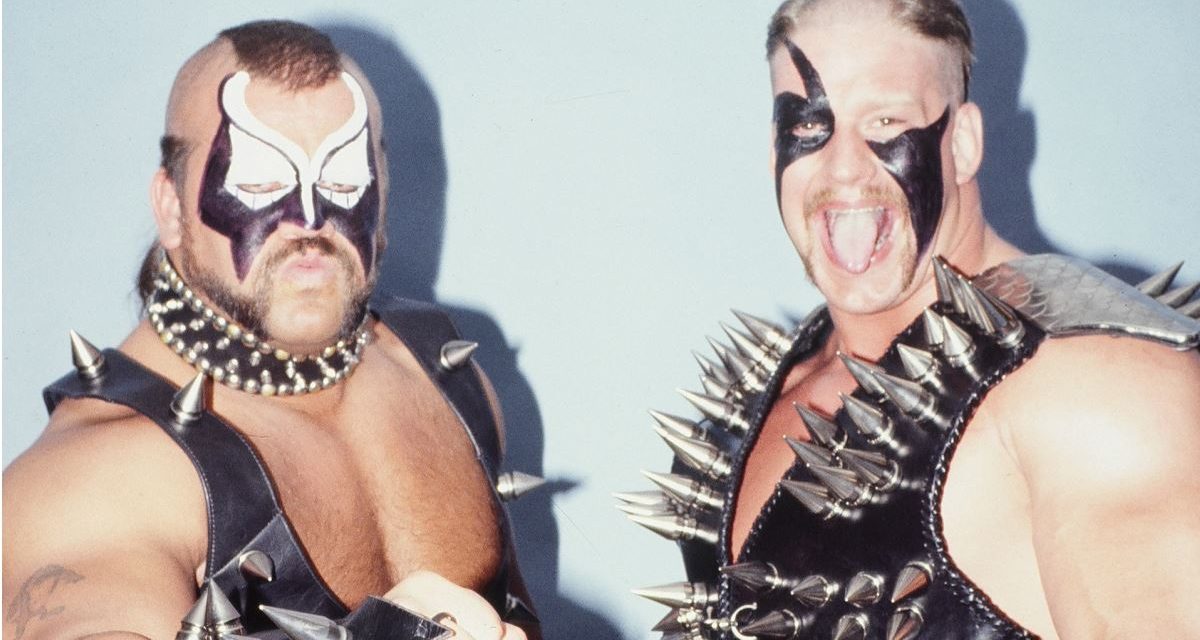It was in a dream that Paul Ellering first envisioned himself as a manager.
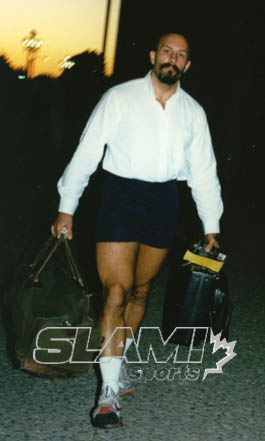
Paul Ellering heads to the arena in 1988 in Buffalo. Photo by Terry Dart.
“I think it was while I was in wrestling camp that I had a premonition-like dream, seeing myself not as a wrestler, but managing wrestlers,” Paul Ellering recently told SLAM! Wrestling from his sports bar in Grey Eagle, Minnesota. “I started out as a wrestler, wrestling for five years on my own, but it wasn’t until Ole (Anderson) gave me the opportunity to manage did I say to myself, ‘Yeah, that’s what I’m supposed to do.'”
Whether it was the power of premonition, fate, or destiny, “Precious” Paul Ellering and his legendary tag team of Hawk and Animal, better known as the Road Warriors, dominated professional wrestling for two decades — immortalizing themselves as the only team to ever hold all three major titles (AWA, NWA, and WWE). As icing on that already decorated cake, Ellering recently learned that, along with Hawk (Michael Hegstrand) and Animal (Joe Laurinaitas), he will be inducted into the Professional Wrestling Hall of Fame Class of 2011, in the tag team category this May in Amsterdam, New York.
“It’s a tremendous honour and a privilege, and it makes me feel good to know that people thought so much of our careers to mark it with such an auspicious occasion as the Pro Wrestling Hall of Fame,” said Ellering. “And to hear that others like Judy Grable, who I remember well, along with Jerry Lawler — we wrestled each other in Memphis for about a year — will be inducted also, it’s just wonderful. And Ivan (Koloff), of course, had been around us a long time and he definitely deserves to be in there.”
Years before the Road Warriors stormed onto the wrestling scene, Ellering wrestled both in singles and in tag team competition throughout the ’70s and early ’80s, trained by AWA promoter Verne Gagne and Eddie Sharkey. One of Ellering’s most notable feuds, wrestling as a babyface, would be a violent and bloody two-year rivalry against Jesse “The Body” Ventura.
Moving on to various territories, from Memphis to Mid-South to Florida, Ellering engaged in heated battles with the likes of Jerry Lawler, Jimmy Valiant, and the Iron Sheik. He would capture the AWA Southern Heavyweight Championship, along with the Southern Tag Team titles with Sheik Ali Hassan.
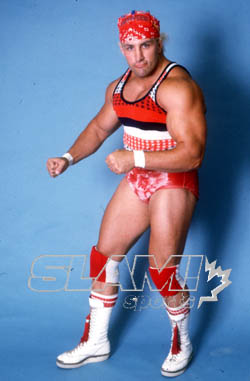
An early posed photo of Paul Ellering. Courtesy of the Wrestling Revue Archives
It was in Georgia Championship Wrestling though where booker Ole Anderson saw Ellering’s potential as a manager. “Ole had said to me, ‘You know, you’re very good on the mic,” recalled Ellering, whose full-time wrestling career was in jeopardy after suffering two serious knee injuries. “That’s where I met the boys (Hawk and Animal) and got into the managing end of it.” said Ellering, whose first task involved the formation of his nefarious faction the Legion of Doom. Originally, it included the Road Warriors, Jake “The Snake” Roberts, King Kong Bundy, and the Spoiler.
“To my recollection… it was the first time that a ‘gang theme’ was used,” said Ellering of his Legion of Doom. “Right now, the gang theme is popular with the (Nexus, and the Corre) in WWE, and years before that with Hogan (and the NWO), but in Atlanta in the early ’80s, the Legion of Doom really was a gang back then, and I was the manager.
“But it only lasted a while as the business was changing so fast with cable TV and the wrestling wars that were developing,” he added. “I saw the potential in Animal and Hawk, who were green at the time, but the tremendous amount of charisma they possessed was evident. I told them that things were falling apart here and that I could get us into the AWA, which brought us all back home where we can cut our own deals. And from that point on, the Legion of Doom became just the three of us for the next 20 years.”
In the new memoir by Joe “Animal” Laurinaitis, The Road Warriors: Danger, Death, and the Rush of Wrestling, Laurinaitis writes of Ellering: “One thing many people don’t know is that Paul was our real manager. All of the other managers in wrestling at the time, guys like Bobby Heenan, Jim Cornette and Jimmy Hart were just playing a character role. Paul, on the other hand, was a true one of a kind. He did everything from book our appearances, flights and hotel rooms to sitting us down and strategizing our matches. Almost every night Hawk and I watched as Paul would sketch out a ring and stick figures on a piece of paper.
“‘Okay guys this is the ring,’ he’d start. ‘Now, we don’t want to do too much at one time, so pick two moves and we’ll add them to the match every week. Once you’ve perfected the timing and execution, we’ll move on.’ Then he’d point with his pencil and gesture with his hands. ‘Now Joe, if you’re here, bring the guy back to the corner and tag Mike. Then throw the guy into the ropes and as you get down and let the guy jump over you, Mike’s going to clothesline the hell of out him.'”
Ellering elaborated: “A picture’s worth a thousand words, and that’s how we’d plan different moves and keep adding to their repertoire, while building bridges. That’s how you learn, and they picked up on it real fast. But the thing you couldn’t teach was the brutality and force, and the in-your-face type of people who they naturally were. They had that going for them, and I just smoothed out those rough edges a bit.”
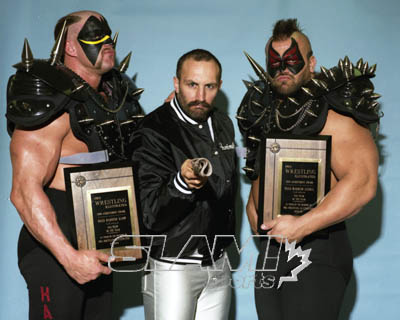
The Road Warriors, Hawk, Paul Ellering, and Animal, with an award. Courtesy of the Wrestling Revue Archives
In Chapter 3, Education of a Road Warrior, Laurinaitis writes of Ellering: “Paul was so fluid and easy to follow we learned something new every night as a result, our confidence started to increase and we were able to elongate our matches. Paul was more than a manager to us. He was the third Road Warrior.”
With a monstrous style and unique image, the Road Warriors would change the landscape of not only tag team wrestling in the years to come, but wrestling as a whole. Long before there was “Stone Cold” Steve Austin, the Road Warriors were an anti-establishment rampaging through every major promotion.
“It was the perfect storm, all of us getting together at that time,” said Ellering, who sometimes joined Hawk and Animal in six-man tags, or substituted if there was an injury. “It helped that I wrestled for many years before I became their manager, as I had the physical size, along with a good amateur background before I got into professional wrestling.
“I was a national champion and had set a world record in weight lifting,” added Ellering, who could deadlift 745 pounds. “Everybody contributed to the Legion of Doom in their own special way. We were three different people, each with our own special talents, but put us all together and we were one very strong, cohesive unit.”
Running roughshod over every established tag team in the AWA and NWA — from the Fabulous Ones, the Midnight Express, and the Four Horsemen to the Briscos, the Freebirds and the Koloffs with Krusher Kruschev — the Legion of Doom sold out arenas across the country. “When the song ‘Iron Man’ started before they walked out, it raised the hair on your back,” said Ellering. “I remember walking to the ring for the War Games and the feeling that went with being a part of something that had never been done before in wrestling.
“And especially being in that enclosed cage with all the tremendous talent on both sides of the rings. It was such a privilege to be there at that point in time in the history of the sport, and to be on the cusp of things that were developing, while setting attendance records every night along the way. We’d walk through the airport and everybody would know you, and it was a big deal.”
It was also a big deal, and unheard of at the time, for a manager to join the wrestlers on tours of Japan, said Ellering. “But it was all for one and one for all. It always the three of us even on international tours. The three musketeers, we were,” he said, the pride obvious in his voice. “The Road Warriors were a big deal in Japan because over there, they love monsters like Godzilla. That’s their thing.
“And Hawk and Animal were incredible with the strength they had, the mystique, along with the spikes and paint. That had never been done before in wrestling, so it was fresh and new everywhere we went. It was unbelievable from the very first tour of Japan, their names were up there with Abdullah the Butcher, King Kong Brody, Stan Hansen, and the Funks, who were all the top Americans in Japan for years and years. I just booked them as an attraction, much like Andre the Giant was. We’d come in and make a big splash, then leave — just like a Clint Eastwood movie.”
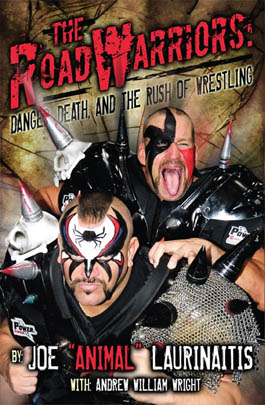
From coast to coast in North America and around the world, the Legion of Doom set their own pace — by their own terms — as they transitioned from territory to territory. “We booked ourselves, and we had a ticket to anywhere we wanted to go,” said Ellering. “We’d sit down at the beginning of the month and I’d just say to the guys, ‘Okay, what days don’t you want to work?’ And then we’d start from there as the phone would ring off the hook every day from different promoters.
“We’d put it together, I’d make the deal as to when we’re coming in and coming out, and arrange transportation. And we did that for years — just totally independent. We’d go to the AWA, then go to work for Don Owen out in the northwest, then off to work for the Von Erichs down in Texas. The only one we didn’t work for at that time was Vince (McMahon), the WWF, so I ran that whole show. And we made a lot of doggone money.”
Inevitably, the Legion of Doom would arrive in the WWE in the summer of 1990 (sans Ellering), engaging in memorable feuds with the likes of Demolition, The Nasty Boys, and Money Inc., winning the WWE World Tag Team Championships on two occasions.
Over the next decade and into the new millennium, the L.O.D. would have several runs with the WWE, along with WCW, New Japan, and various independent promotions, until the unexpected death of Hawk in 2003.
“We were all together at our 20-year reunion in Chicago. I think it was in June, then Hawk died in October,” said Ellering, with a touch of melancholy in his voice. “How fitting was that? This promoter put that show on in Chicago and brought the three of us all together to celebrate the 20-year reunion of the Legion of Doom. And that was the last time we’d be together.”
After a long pause, Ellering continued: “Not a day goes by where I don’t think of him, and I’ll see him one day in heaven. You know, I’m not an angel, but I know angels. And Hawk is an angel, and he’s standing up there looking down. And I talk to him a lot.”
Indeed, when Hawk died, the wrestling world lost one of its most charismatic personalities of all time. “So many memories, but that’s the way life works,” said Ellering, who these days enjoys running The Historical Rock Tavern with his family. He is also an experienced sled dog racer. “Right now I’m watching the Iditarod (trail sled dog race), and that’s a thousand mile race. You run that one time, but you relive it a thousand times where, in your mind, you relive every checkpoint and every section of the race. And that’s the way wrestling is for me.
“I can think of all these matches and just relive them — their presence in my memory — and I can pull them out whenever I want to relive them. Vividly, so many of those matches live on in my mind, and all the fun times I had with Mike and Joe.”
It’s been said that the death of Hawk marked not only the end of the Road Warriors, but the end of an era. “When it’s all said and done, I’ve said many times, they became the greatest tag team of our time. And very possibly, the greatest tag team of all time,” Ellering said of their legacy.
“That’s why I’m so grateful of the fact that we’re being inducted into the Pro Wrestling Hall of Fame in Amsterdam, New York,” he concluded. “Like I said, it all began for me as a premonition-dream — I don’t know how the mind works — but somehow I knew that this was going to be my forte. To do something like what we had is truly special. Anything of magnitude, if you can do it in this life, is a big a deal. I just feel so fortunate to have been a part of it.”
Sounds like a dream come true.
RELATED LINKS
- Pro Wrestling Hall of Fame website
- Road Warriors story archive
- ROAD WARRIORS PHOTO GALLERY
